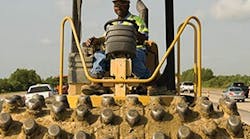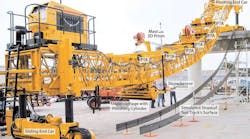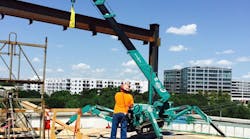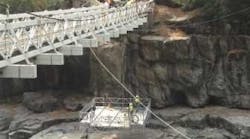Milwaukee's recently completed Marquette Interchange project was an ambitious and successful effort to improve the flow of traffic through Wisconsin's largest metropolitan area.
The four-year project was just finished in August, 2008 – three months ahead of schedule, about $10 million under its $810-million budget, and with a near-perfect safety record.
The last, and most-complex, section of the project to be built was the downtown “core,” where Interstates 43, 94 and 794 meet.
Work on the Marquette Interchange consisted of both demolition and complete reconstruction, as all left-exit ramps were removed, merge lanes were lengthened, ramps were widened,and an entirely new fifth level was added.
Constructing the core was a job so massive and complex that three of the state's largest bridge contractors — Lunda Construction Co. (Black River Falls, WI), Edward Kraemer & Sons, Inc. (Plain, WI), and Zenith Tech, Inc. (Waukesha, WI) – formed Marquette Constructors, LLC, a joint venture, to build it.
Traditional projects might call for the reconstruction of a bridge, widening of a road, or construction of a new on or off ramp.
At any given time, the Marquette had all that – and more – going on simultaneously.
During construction of the core, the job site teemed with a fleet of aerial lifts involved in work ranging from demolition to girder erection.
Brady Frederick, project manager for Marquette Constructors, LLC, said that for months in a row, about 25 to 30 Genie brand aerial lifts worked throughout the core.
The need, says Frederick, was driven by the sheer demand of many structures going up at once. “Generally, a contractor will have a single crew erecting columns and setting steel. We had eight to 10 crews just building columns on different bridges, each in a different stage of construction.”
All of the work was being done from 30 to 120 feet in the air, so aerial lifts were the most efficient way to access the work areas and still remain mobile.
Marquette Constructors was supported by the downtown Milwaukee office of Fabco Rents, which Frederick credits with having done an excellent job of meeting the contractor's needs throughout the project.
One example: Fabco offered classes in safe operation of the Genie aerial lifts that were on site. “After that, we even had one of our own people trained to provide similar instruction to new personnel as they come on board. There is just no substitute for a safe, informed workforce,” Frederick says.
The Marquette Interchange job had an owner-controlled insurance program (OCIP) that required 100-percent anti-fall tie-off for any worker working more than six feet up.
“The lifts make compliance with the tie-off demands easy and workable,” says Frederick, who noted that variously sized units helped in applications that ranged from pile driving to concrete forming, acetylene-based demolition, girder placement, and more.
No place girders for bridges and overpasses, large cranes picked girders of steel or precast concrete measuring up to 150 feet long and weighing up to 75 tons. The cranes were aided by ironworkers in aerial lifts who helped guide the girders precisely into position. After the girders had been set, workers in aerial lifts placed and bolted the diaphragms that connect adjacent girders.
Frederick says many of the forms taking shape at the Marquette site were complex, often making extended work necessary and drawing upon the reach and versatility of the lifts in those applications, too.
“The forms for the I-43 bridge just south of St. Paul Avenue, for example, took us better than three weeks to erect; they were that complex,” he says. “They were not cookie-cutter forms; each one was designed specifically to meet the needs of its application. And, since many rose as high as 120 feet, the Genie lifts we had on site – offering from 65 feet to 135 feet of reach – made form access and construction a breeze. These units have proven extremely reliable; they were the workhorse of this project for us.”




